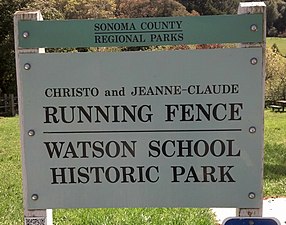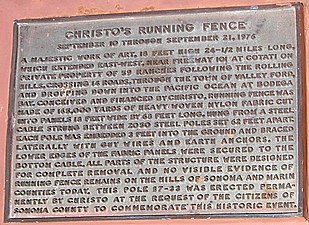Running Fence
| Running Fence | |
|---|---|
 | |
| Artist | Christo and Jeanne-Claude |
| Year | September 10, 1976 |
| Type | Installation art |
| 38°19′4″N122°55′28″W/ 38.31778°N 122.92444°W | |
Running Fencewas aninstallation artpiece byChristo and Jeanne-Claude,which was completed on September 10, 1976. The art installation was first conceived in 1972, but the actual project took more than four years to plan and build.[1]After it was installed, the builders removed it 14 days later, leaving no visible trace behind.[2]
Installation
[edit]The art installation consisted of a veiled fence 24.5 miles (39.4 km) long extending across the hills ofSonomaandMarincounties in northernCalifornia,United States.The 18-foot (5.5 m) high fence was made of 200,000 square meters (2,222,222 square feet) of heavy woven white nylon fabric, which created 2,050 panels, and was hung from steel cables by means of 350,000 hooks. The cables were supported by 2,050 steel poles (each: 6.4 meters / 21 feet long or 9 centimeters / 3.5 inches in diameter) embedded 1 meter (3 feet) into the ground, braced by steel guy wires (145 kilometers / 90 miles of steel cable), 14,000 earth anchors, and without any concrete.[2]
The route of the fence began nearU.S. Highway 101and crossed 14 roads and the private property of 59 ranchers to reach thePacific Oceansouth ofBodega Bay.The fence entered the Pacific Ocean at a point about midway between theEstero Americanoand theEstero de San Antonio,in northwestern Marin County.[3]The art project required 42 months of collaborative efforts, 18 public hearings, 3 sessions at the Superior Courts of California, and the drafting of an Environmental Impact Report (EIR); the requiredEIRfor the piece was 450 pages long.[2]
All expenses for the temporary work of art were paid by Christo and Jeanne-Claude through the sale of studies, preparatory drawings and collages, scale models and original lithographs.[2]
Originally conceived in 1972 asCurtains for West Berlinto block the view of theBerlin Wall,[4]the project relocated to rural Sonoma and Marin Counties just south of the historic Russian settlements ofFort Rossand PortRumyantsevatBodega Bayin the Mexican bulwark ofRancho Americano.It is also said to have been partly inspired by fences demarcating theContinental DivideinColorado.[1]Christo emphasized that he considered Running Fence to encompass its social, legal, and technical dimensions.[5]
An alternative location at Harmony, California for a 24.5 mile fence installation was scouted by Jeanne-Claude and Christo in 1973.[6]
Legacy
[edit]The piece is commemorated by historic markers atWatson SchoolnearBodega, California[7]and atState Route 1inValley Ford, California.In December 1976, the County Landmarks Commission, County of Sonoma designated the Valley Ford site (pole #7-33) as History Landmark #24.[8]
The largest remaining intact and continuous section of theRunning Fencehangs below the ceiling of theRio TheaterinMonte Rio, California.[9]
Between April 1, 2010 through September 25, 2010,Christo and Jeanne-Claude: Remembering the Running Fencewas on display at the Smithsonian American Art Museum.[10]The exhibition comprised over 350 archival and related works and photographs, and visitors could touch the actual nylon fabric panels and steel poles from the original work of art.[10]
TheCharles M. Schulz MuseuminSanta Rosahas a permanent exhibit on Christo featuring a portion of fabric from the Running Fence. Schulz'sPeanuts comic stripfeatured Christo's art and the Running Fence in 1978.[11]
Documentary
[edit]The piece was the subject of a 1978 documentary filmRunning FencebyAlbert and David Maysles.[12][13]The film includes scenes showing the local response to the project, which ranged from excitement to resentment and active protest. Several Californians including Expressionist painterByron Randallprotested the piece on the grounds of both land infringement and lack of artistic merit; however others appreciated the beauty of the work and in the end the project was completed.[14][15][13]
Gallery
[edit]-
Sign atWatson School
-
One of two commemorative markers in Valley Ford, California
-
The Running Fence's 24.5 mile course with Russian, Mexican, and American historic features noted.
See also
[edit]- Site-specific art
- Land art
- Public art
- List of Sonoma County Regional Parks facilities
- Sonoma County Historic Landmarks and Districts
References
[edit]- ^ab"Christo and Jeanne-Claude".Archived fromthe originalon 2008-03-06.Retrieved2008-01-31.
- ^abcd"Running Fence".Archived fromthe originalon 2009-01-26.Retrieved2008-01-31.
- ^Environmental Science Associates; Sonoma County (Calif.). Planning Dept (1975).Running fence: draft environmental impact report: prepared under contract to the Sonoma County Planning Department, Santa Rosa, California.Smithsonian Libraries. Foster City, Calif.: Environmental Science Associates.
- ^"Christo".LIVES RETOLD.Retrieved2023-10-21.
- ^Chamberlain, Colby (2017-04-01)."THE POLITICS OF CHRISTO AND JEANNE-CLAUDE'S RUNNING FENCE".Artforum.Retrieved2023-10-21.
- ^"Running Fence, Sonoma and Marin Counties, California, 1972-76 | Smithsonian American Art Museum".americanart.si.edu.Retrieved2024-05-27.
- ^""Watson School Historic Park"".Retrieved2008-01-31.
- ^"Over The River: Prizes and Awards".Retrieved2010-10-11.
- ^"Rio Theater owners optimistic about its Kickstarter campaign helping it stay alive".Retrieved2013-05-04.
- ^ab"Christo and Jeanne-Claude: Remembering the Running Fence".Smithsonian American Art Museum.Retrieved2019-11-01.
- ^Yazel, Faith (2020-07-01)."In Memory of the Artist, Christo".Charles M. Schulz Museum.Retrieved2023-10-21.
- ^"Running Fence (1978)".Retrieved2008-01-31.
- ^abMalin, Janet"'Running Fence' Films Story of an Art Event:The Program ".The New York Times.April 11, 1978.RetrievedSeptember 20,2018.
- ^Chernow, Burt; Volz, Wolfgang (2002).Christo and Jeanne-Claude.p. 240. NY: St. Martin's Press.
- ^Vogels, Jonathan B. (2010).The Direct Cinema of David and Albert Maysles.pp.111-123. SIU Press.
Further reading
[edit]- Chamberlain, Colby (April 2017)."Colby Chamberlain on the politics of Christo and Jeanne-Claude's Running Fence".Artforum.Vol. 55, no. 8.ISSN0004-3532.
- Kaplan, Helaine (1977). "Wrapping the Coast with Christo's 'Running Fence'".Landscape Architecture.67(1): 56–61.ISSN0023-8031.JSTOR44666469.
- Tomkins, Calvin (June 2, 2020)."A Tribute to Christo's Unforgettable Art Works".The New Yorker.RetrievedJune 3,2020.
External links
[edit]- 1976 sculptures
- Art in the San Francisco Bay Area
- Fabric sculptures
- History of Marin County, California
- History of Sonoma County, California
- History of the San Francisco Bay Area
- Installation art works
- Outdoor sculptures in California
- Parks in Sonoma County, California
- West Marin
- Works by Christo and Jeanne-Claude



